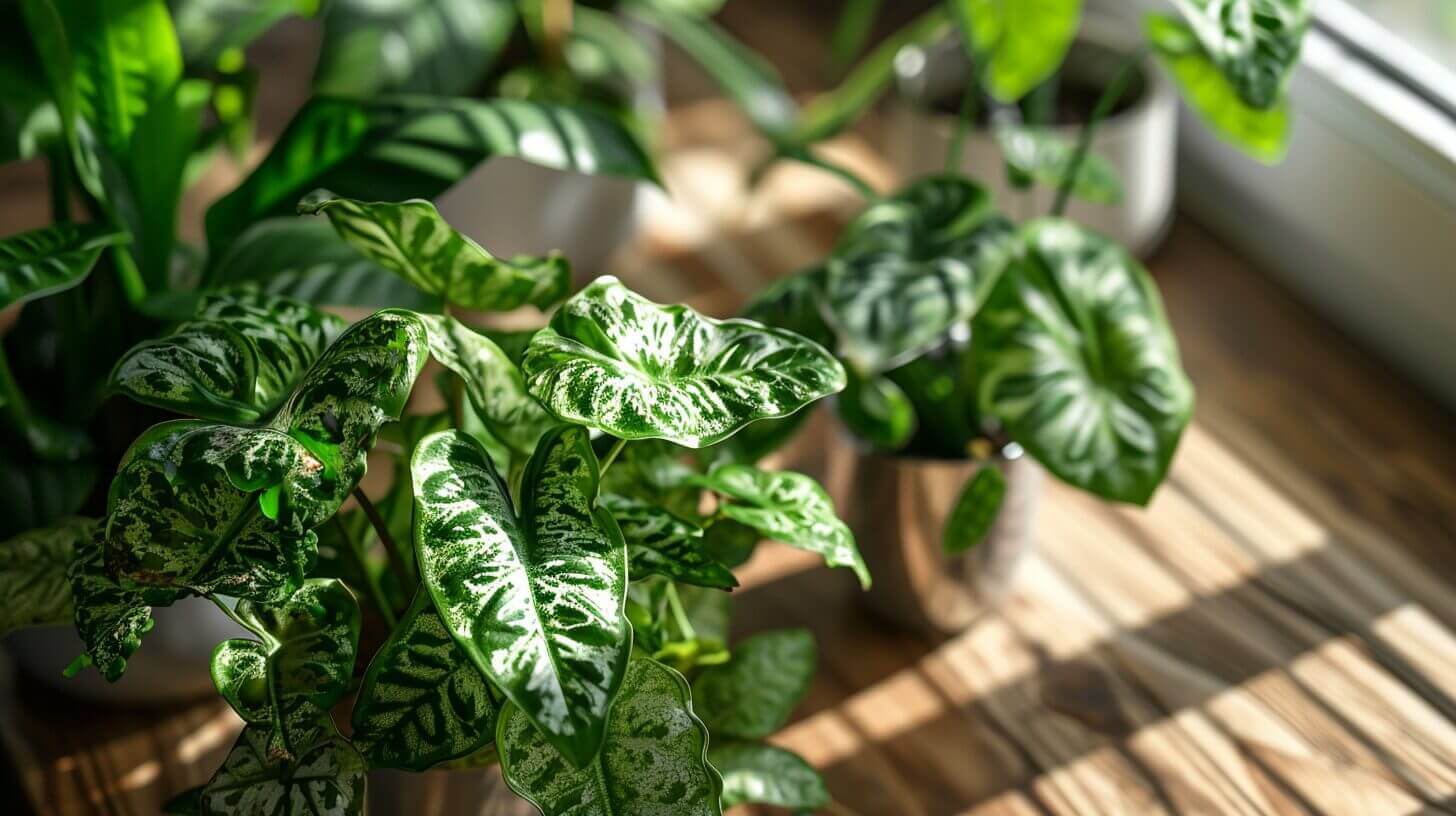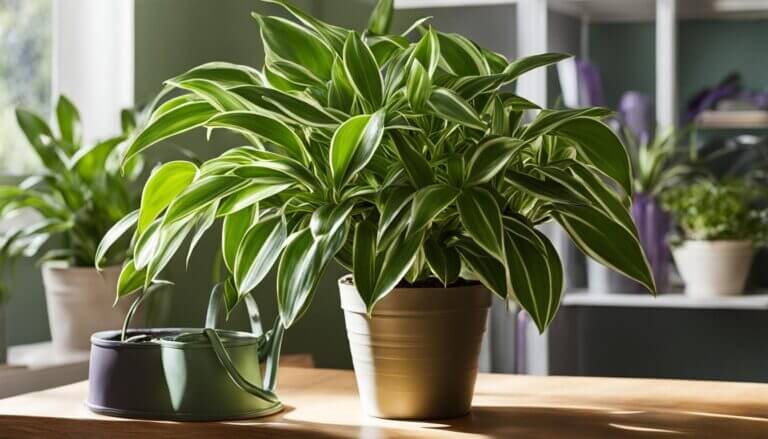Are you craving a touch of nature in your home? Look no further than the stunning Arrowhead Plant(Syngonium podophyllum). With its vibrant foliage and easy care requirements, this plant is the perfect addition to your indoor jungle.
In this complete care guide, we’ll walk you through everything you need to know to keep your Arrowhead Plant thriving. From lighting and watering to humidity and fertilizing, we’ve got you covered.
Get ready to create a lush oasis that you can truly call your own.
Key Takeaways
- Provide bright, indirect sunlight by placing the plant near a window or using LED grow lights if natural light is not available.
- Water thoroughly and ensure proper drainage to prevent root rot.
- Maintain a high humidity environment by misting the leaves and using a tray filled with water nearby.
- Fertilize during the growing season and address common issues like pests and pruning to ensure a healthy Arrowhead plant.
Lighting Requirements
To ensure the health and growth of your Arrowhead plant, you should place it in a location with sufficient light. When it comes to lighting, there are two options: natural and artificial.
Natural light is ideal for your Arrowhead plant, as it closely mimics its natural habitat. Find a spot near a window where your plant can receive bright, indirect sunlight. Avoid exposing it to direct sunlight, as it can scorch the leaves.
If natural light isn’t available, you can use artificial lighting. LED grow lights are the best choice, as they provide the right spectrum of light for plant growth. Place the lights about 12 inches above the plant and keep them on for 12-14 hours a day.
Arrowhead Plant Care – Watering Schedule
Make sure you water your Arrowhead plant regularly to keep it healthy and thriving. Proper watering is crucial for the overall health of your plant, but it’s important to find the right balance.
Here are some tips to help you establish a watering schedule for your Arrowhead plant:
- Check the soil moisture: Before watering, check the top inch of soil. If it feels dry to the touch, it’s time to water your plant. However, if it’s still moist, hold off on watering for a little longer.
- Water thoroughly: When watering, make sure to water your Arrowhead plant thoroughly until water drains out of the bottom of the pot. This ensures proper hydration and helps prevent the risk of overwatering.
- Ensure proper drainage: To avoid overwatering risks, it’s crucial to provide your Arrowhead plant with proper drainage. Choose a pot with drainage holes and use well-draining soil to allow excess water to escape.
Syngonium Podophyllum Care – Humidity Needs
Maintain the Arrowhead plant’s optimal humidity levels to promote its growth and health.
Arrowhead plants thrive in high humidity environments, so it’s important to provide them with the right conditions. Whether you have your plant indoors or outdoors, you can create a humid environment by misting the leaves regularly. This will help mimic the plant’s natural habitat and prevent the leaves from drying out.
Another option is to place a tray filled with water near the plant, allowing the water to evaporate and increase the humidity around it. Remember to avoid placing the plant near drafts or vents, as this can dry out the leaves.
When it comes to potting mix options, choose a well-draining mix that retains moisture without becoming waterlogged. This will help maintain the plant’s humidity needs while preventing root rot.
Grow Arrowhead Indoor – Fertilizer Tips
To ensure optimal growth and health for your Arrowhead plant, it’s important that you fertilize it regularly. Fertilizers provide the necessary nutrients that the plant needs to thrive. Here are some fertilizing tips to help you take care of your Arrowhead plant:
- Choose the right fertilizer: There are two main types of fertilizers – organic and synthetic. Organic fertilizers, such as compost and worm castings, are derived from natural sources and provide slow-release nutrients. Synthetic fertilizers, on the other hand, are chemically manufactured and provide immediate nutrients.
- Follow the recommended dosage: Over-fertilizing can harm your plant, so make sure to follow the instructions on the fertilizer package. It’s better to slightly under-fertilize than to over-fertilize.
- Fertilize during the growing season: Arrowhead plants actively grow during spring and summer, so this is the best time to fertilize. Reduce or stop fertilizing during the winter months when the plant is dormant.
Troubleshooting Common Issues
If you notice any issues with your Arrowhead plant, there are several troubleshooting steps you can take to address them. Common pests can sometimes invade your Arrowhead plant, such as spider mites, aphids, and mealybugs. To combat these pests, you can use insecticidal soap or neem oil spray. Additionally, proper pruning techniques can help maintain the health of your plant. Regularly pruning dead or yellowing leaves will promote new growth and prevent the spread of diseases. When pruning, make sure to use clean, sharp pruning shears to avoid damaging the plant. Remember to always disinfect your tools before and after pruning to prevent the spread of any potential diseases. By addressing these common issues and practicing proper care techniques, you can ensure a healthy and thriving Arrowhead plant.
| Common Pests | Pruning Techniques |
|---|---|
| Spider mites | Regular pruning |
| Aphids | Removing dead leaves |
| Mealybugs | Using clean, sharp pruning shears |
Frequently Asked Questions
Can I Propagate an Arrowhead Plant Using Stem Cuttings?
Yes, you can propagate an arrowhead plant using stem cuttings. This is one of the most common propagation methods for this plant.
To do this, simply cut a healthy stem from the parent plant, making sure it has at least two nodes. Remove the lower leaves and place the cutting in water or a well-draining soil mix.
Keep the cutting in a warm and humid environment, and within a few weeks, you should start to see roots forming.
How Often Should I Repot My Arrowhead Plant?
To ensure your arrowhead plant thrives, it’s important to know how often to repot it. Repotting frequency depends on the signs of being root bound.
When the roots start to outgrow the current pot, it’s time for a new one. Look for roots poking out from the drainage holes or circling the bottom of the pot.
Repotting every 1-2 years is usually sufficient. This allows the plant to have enough space to grow and prevents it from becoming root bound.
Are Arrowhead Plants Toxic to Pets?
Are you concerned about the toxicity of arrowhead plants to your beloved pets?
Well, let me assure you that arrowhead plants, also known as Syngonium Podophyllum, can indeed be toxic to dogs and cats if ingested.
To keep your furry friends safe, it’s important to place these plants out of their reach or consider alternative pet-friendly options.
Always prioritize the well-being of your pets and take necessary precautions to ensure their safety around arrowhead plants.
Can I Place My Arrowhead Plant Outdoors During the Summer?
During the summer, you can definitely place your arrowhead plant outdoors! It thrives in outdoor conditions, benefiting from the natural sunlight and fresh air.
Placing your arrowhead plant outside allows it to grow larger and develop more vibrant foliage. Just make sure to choose a spot with indirect sunlight to prevent the leaves from burning.
Remember to bring it back inside before the temperature drops in the evening, as arrowhead plants prefer warmer climates.
What Should I Do if My Arrowhead Plant’s Leaves Start Turning Yellow?
Why are your arrowhead plant leaves turning yellow?
Yellowing leaves in arrowhead plants can be caused by a variety of factors, including overwatering, underwatering, lack of sunlight, or nutrient deficiencies.
To prevent yellowing leaves, make sure to water your plant properly, allowing the soil to dry out slightly between waterings.
Provide it with bright, indirect sunlight and fertilize it regularly with a balanced houseplant fertilizer.
Keeping a close eye on the plant’s needs will help maintain its vibrant green foliage.







